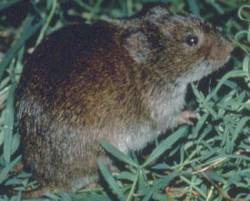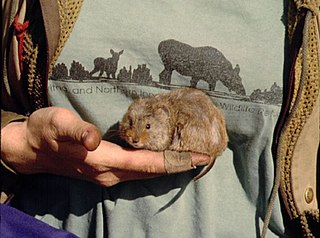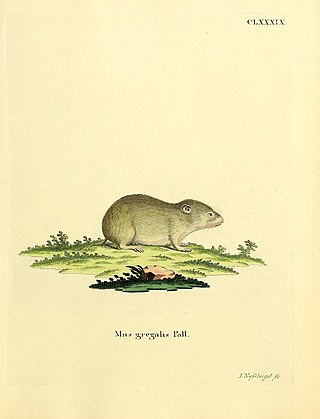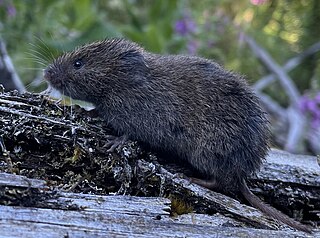
The Townsend's mole is a fossorial mammal in the family Talpidae, and is the largest North American mole. It was named after the American naturalist John Kirk Townsend. The name was selected at the request of Thomas Nuttall as a patronym to honor Townsend's contribution.

The eastern meadow vole, sometimes called the field mouse or meadow mouse, is a North American vole found in eastern Canada and the United States. Its range extends farther south along the Atlantic coast.

Microtus is a genus of voles found in North America, Europe and northern Asia. The genus name refers to the small ears of these animals. They are stout rodents with short ears, legs and tails. They eat green vegetation such as grasses and sedges in summer, and grains, seeds, root and bark at other times. The genus is also called "meadow voles".

The North American water vole or just water vole is the largest North American vole. It is found in the northwestern United States and southern parts of western Canada. This animal has been historically considered a member of genus Arvicola, but molecular evidence demonstrates that it is more closely related to North American Microtus species. Water voles are on the USDA Forest Service Region 2 sensitive species list because they maintain very small populations and there is high concern that their required habitat may be declining.

The tundra vole or root vole is a medium-sized vole found in Northern and Central Europe, Asia, and northwestern North America, including Alaska and northwestern Canada. In the western part of the Netherlands, the tundra vole is a relict from the ice age and has developed into the subspecies Alexandromys oeconomus arenicola.

The northern red-backed vole is a small slender vole found in Alaska, northern Canada, Scandinavia and northern Russia.

The taiga vole is a large vole found in northwestern North America, including Alaska and northwestern Canada. The name "taiga vole" comes from its living in the boreal taiga zone. It is also sometimes called the yellow-cheeked vole or chestnut-cheeked vole because of the rusty-yellow color on its face around its vibrisae (whiskers); The taiga voles derive their name from these features: "xantho" is Greek for yellow and "gnathus" is Greek for jaw. It is typically much larger than most other North American voles, especially those from the genus Microtus.

The singing vole, is a medium-sized vole found in northwestern North America, including Alaska and northwestern Canada.

The rock vole, also known as the yellow-nosed vole, is a medium-sized species of vole found in eastern North America.

The eastern heather vole,, is a small North American vole. Until recently, this species was considered to belong to the same species as the western heather vole, Phenacomys intermedius. It is also called the Ungava vole.

The short-tailed field vole, short-tailed vole, or simply field vole is a grey-brown vole, around 10 cm in length, with a short tail. It is one of the most common mammals in Europe, with a range extending from the Atlantic coast to Lake Baikal. These voles are found in moist grassy habitats, such as woodland, marsh or on river banks. Although they make shallow burrows, they usually build nests above ground. They are an important food source for owls and some other predators and their population size tends to peak and trough cyclically. Field voles breed prolifically, mainly in summer, but often all year round, even under snow. Females produce up to seven litters a year, each averaging from four to six young which are weaned after about fourteen days. The short-tailed field vole is both widespread and common and is listed as being of "Least Concern" by the IUCN.

The gray-tailed vole also known as the gray-tailed meadow vole or gray-tailed meadow mouse, is a rodent in the genus Microtus of the family Cricetidae. Voles are small mammals, and this species lies roughly in the middle of their size range. First collected in 1895, it is endemic to the Willamette Valley, Oregon, and Clark County, Washington, in the Pacific Northwest region of North America. Historically, they were found in the prairie areas of the Valley and, though many of these areas have been converted for agricultural purposes, these animals remain common. For reasons that remain unclear, vole population densities in any area may fluctuate widely from season to season and year to year. They are preyed upon by owls, hawks, and carnivorous mammals, and their parasites include fleas and ticks. These voles build burrows and complex tunnel networks, which they sometimes share with other burrowing animals. Relatively little is known about their behavior in the wild, because they are elusive and unlikely to enter traps.

The reed vole is a species of vole. It is found in northern and central Eurasia, including northern China and the Korean Peninsula. This species is somewhat larger and longer-tailed than most other voles.

The California vole is a type of vole which lives throughout much of California and part of southwestern Oregon. It is also known as the "California meadow mouse", a misnomer as this species is a vole, not a mouse. It averages 172 mm (6.8 in) in length although this length varies greatly between subspecies.
The Mediterranean pine vole is a species of rodent in the family Cricetidae. It is found in France, Andorra, Portugal, and Spain where it lives in a network of shallow tunnels.

The narrow-headed vole is a species of rodent in the family Cricetidae. It was previously placed in the genus Microtus, but modern listings either lump this into genus Lasiopodomys or split it out into Stenocranius. It ranges over northern and central Asia.
Maximowicz's vole is a species of rodent in the family Cricetidae. It is found in northeastern China, Mongolia, and eastern Russia.

The creeping vole, sometimes known as the Oregon meadow mouse, is a small rodent in the family Cricetidae. Ranging across the Pacific Northwest of North America, it is found in forests, grasslands, woodlands, and chaparral environments. The small-tailed, furry, brownish-gray mammal was first described in the scientific literature in 1839, from a specimen collected near the mouth of the Columbia River. The smallest vole in its range, it weighs around 19 g. At birth, they weigh 1.6 g, are naked, pink, unable to open their eyes, and the ear flaps completely cover the ear openings. Although not always common throughout their range, there are no major concerns for their survival as a species.

The camas pocket gopher, also known as the camas rat or Willamette Valley gopher, is a rodent, the largest member in the genus Thomomys, of the family Geomyidae. First described in 1829, it is endemic to the Willamette Valley of northwestern Oregon in the United States. The herbivorous gopher forages for vegetable and plant matter, which it collects in large, fur-lined, external cheek pouches. Surplus food is hoarded in an extensive system of tunnels. The dull-brown-to-lead-gray coat changes color and texture over the year. The mammal's characteristically large, protuberant incisors are well adapted for use in tunnel construction, particularly in the hard clay soils of the Willamette Valley. The gophers make chattering sounds with their teeth; males and females make purring sounds when they are together, and the young make twittering sounds. Born toothless, blind and hairless, the young grow rapidly before being weaned at about six weeks of age.

Townsend's pocket gopher is a species of pocket gopher endemic to the northwestern United States.




















